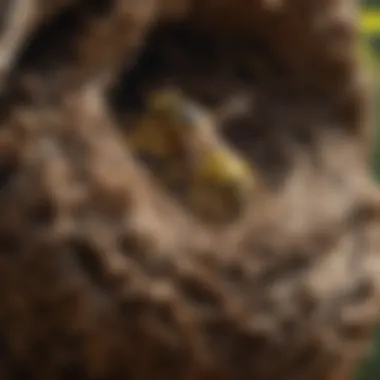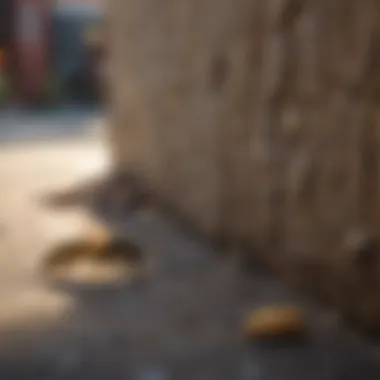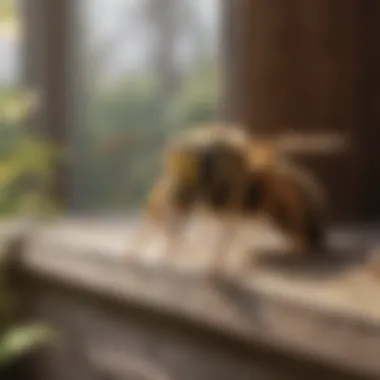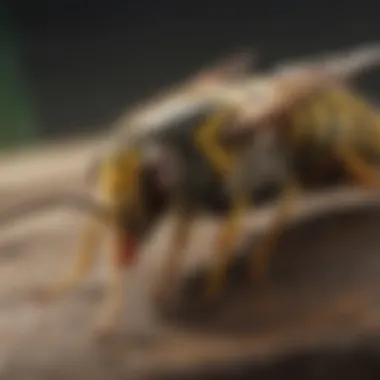Yellow Jackets in Your Home: Risks and Remedies


Intro
Yellow jackets are a group of wasps that can pose a significant threat when they invade residential spaces. Understanding their behaviors, nesting habits, and the risks they bring is crucial for homeowners. These pests are often mistaken for other insect species, which can lead to ineffective control measures. In this article, we will delve into pest identification, prevention strategies, and various treatment options to manage yellow jackets effectively.
Pest Identification
Detailed Descriptions of Common Pests
Yellow jackets belong to the family Vespidae. They are typically characterized by their yellow and black markings, which can vary between species. The western yellow jacket, for instance, has a more pronounced black color compared to the eastern counterpart. They are about 1/2 to 3/4 inches long and have a slender waist and legs.
Signs and Symptoms of Infestations
Detecting a yellow jacket infestation early on can prevent further complications. Common signs include:
- Increased wasp activity: Frequent sightings of yellow jackets around your home, especially during late summer and early fall, indicate a potential problem.
- Visible nests: Nests may be found in attics, wall voids, or hidden under eaves. These nests are often made of a papery substance that yellow jackets create by chewing wood fibers mixed with their saliva.
- Aggressive behavior: If yellow jackets are provoked, they tend to defend their nests aggressively, which can pose a danger to individuals nearby.
Prevention Strategies
Home Maintenance Tips for Pest Prevention
Proactive measures play a vital role in keeping yellow jackets at bay. Consider implementing the following strategies:
- Seal entry points: Inspect your home for gaps, cracks, or holes. Use caulk or other appropriate materials to seal these openings.
- Proper garbage management: Ensure that trash cans are tightly sealed. Yellow jackets are attracted to food scraps and sugary substances.
- Regular yard maintenance: Trim back overgrown shrubs and remove debris that could provide nesting sites.
Natural Deterrents and Barriers
Employing natural barriers can effectively deter yellow jackets. Some methods include:
- Peppermint oil: This natural oil serves as an effective repellent. Mix it with water and spray around known entry points.
- Vinegar traps: Create traps using a mixture of vinegar and sugar water. This method attracts yellow jackets while preventing them from entering your home.
Treatment Options
Overview of Chemical vs. Natural Treatments
When faced with an established yellow jacket nest, homeowners may consider several treatment options. Chemical treatments usually offer quick results but require caution to avoid harming non-target species. Natural treatments are less harmful but may take longer to show effect.
Step-by-Step Guides for DIY Treatments
For those who prefer a DIY approach, here are simple methods:
- Locate the nest: Ensure you can identify the nest without provoking the wasps. Always wear protective clothing.
- Choose a treatment method: Use a commercial insecticide, available at many hardware stores, specifically designed for yellow jackets. For natural methods, prepare a soap solution by mixing water with dish soap.
- Apply in the evening: Yellow jackets are less active at dusk. Carefully spray your chosen solution on the nest from a safe distance.
- Monitor the area: After treatment, keep an eye on the site for further activity. You may need to repeat the process if necessary.
Effective management of yellow jackets is essential not only for personal safety but also for maintaining a peaceful living environment.
This guide aims to equip homeowners with the knowledge needed to identify, prevent, and treat yellow jacket issues. Taking timely action can ultimately preserve the integrity of one’s home and ensure a safe living space.
Prolusion to Yellow Jackets
Understanding yellow jackets is essential for homeowners. These wasps can become a nuisance, especially when they invade living spaces. This section examines the characteristics of yellow jackets, their behavior, and why they may enter homes. Homeowners need to recognize the threat that yellow jackets pose. This knowledge is crucial for addressing the issues they may create.
Defining Yellow Jackets
Yellow jackets are a specific type of wasp belonging to the genus Vespula. Commonly mistaken for bees, these insects are distinguished by their slender bodies covered with bright yellow and black stripes. They are social insects, living in colonies that can reach thousands. Unlike bees, yellow jackets have smooth stingers and can sting multiple times, making their encounters with humans particularly uncomfortable.
Their nests are typically found in sheltered areas, often in the ground or within structural voids of buildings. This characteristic nesting habit is important. It explains why yellow jackets often find their way into homes, especially in late summer and early fall.
Distinguishing Yellow Jackets from Other Wasps


Many people confuse yellow jackets with other types of wasps, including hornets and paper wasps. One key difference is the yellow jacket's more robust body and distinct coloration. Hornets, like the bald-faced hornet, are generally larger and have a more rounded shape, while paper wasps are elongated with a more slender build.
Additionally, yellow jackets are more aggressive than most wasps. They are attracted to human food and try to join outdoor activities, giving them a reputation as pests. In many cases, it is important to identify them correctly to apply proper control measures.
Recognizing these differences is essential for any homeowner facing a potential infestation. Knowing what kind of wasp they are dealing with can aid in taking the right steps for prevention and control.
"Proper identification of yellow jackets allows for more effective management strategies."
In summary, understanding yellow jackets encompasses more than just their looks. It involves knowing their behavior, nests, and differences from other insects, laying the groundwork for better preparation and response to their intrusion.
Understanding Yellow Jacket Behavior
Understanding the behavior of yellow jackets is essential for homeowners facing the challenges these pests present. Knowledge of their social structure, nesting habits, and seasonal activity patterns can empower homeowners to take informed actions to prevent infestations. Recognizing these specific behaviors helps in identifying the best time and methods to deter yellow jackets, thus reducing potential threats to households.
Social Structure and Nesting Habits
Yellow jackets have a complex social structure. They live in colonies, which can vary in size with some containing thousands of individuals, especially during peak summer months. Each colony has a queen, workers, and drones. The queen is responsible for laying eggs, while the workers perform various tasks, including foraging for food, maintaining the nest, and protecting the colony.
The nesting habits of yellow jackets are also noteworthy. They often choose sheltered locations for their nests, which can be underground, in wall cavities, or inside structures. Nests start small in the spring as the queen lays eggs. As the colony grows, so too does the nest. In understanding this growth pattern, homeowners can intercept the problem early. Observing signs like increased yellow jacket activity near potential nesting spots is crucial.
"Preventive measures are often most effective before the colony reaches full size in late summer."
Typically, yellow jackets prefer to nest in locations that offer warmth and some degree of protection from predation or environmental factors. Knowledge of these preferences allows homeowners to assess their property for potential nesting sites and take proactive actions.
Seasonal Activity Patterns
Seasonal changes significantly affect yellow jacket behavior. In spring, the queen emerges from hibernation and begins nest construction, which explains a rise in activity during this time. By summer, colonies reach their peak populations. Increased foraging behavior is common as workers seek food sources. They are primarily scavengers and are often drawn to human food, especially sugary treats, which increases the likelihood of encounters.
As autumn approaches, the colony begins to decline, resulting in more aggressive behaviors. This is partly because food sources become scarce, and yellow jackets search for sustenance. With many stopping to forage near homes, there can be an uptick in issues related to infestations.
To summarize, understanding yellow jacket behavior involves recognizing the social structure and nesting preferences, as well as seasonal patterns that influence their activity. Such awareness is essential for effective prevention and control strategies.
Reasons for Yellow Jackets Entering Homes
Understanding why yellow jackets invade homes is essential for homeowners. Knowing these reasons helps individuals take preemptive measures to deter these pests. Yellow jackets are not only a nuisance; they can pose real health risks, especially when they nest close to human activity. The more awareness homeowners have, the better equipped they are to handle such intrusions effectively.
Attraction to Food Sources
Yellow jackets are often attracted to food sources, making residential areas particularly appealing. During the late summer and early fall, their foraging becomes aggressive as they seek higher calories for nest maintenance and the nourishment needed for new queens in the upcoming season. Common food sources that entice yellow jackets include:
- Garbage bins: Open or overflowing trash is like a buffet for them.
- Food spills: Leaving food exposed during outdoor barbecues or picnics can attract them quickly.
- Sweet liquids: Beverages like soda or fruit juices can draw yellow jackets.
These insects are opportunistic feeders, meaning they will explore their surroundings. This means a neglected garden or untamed shrub can invite them to search indoors for food. Homeowners need to be vigilant about maintaining clean environments and could benefit from proper waste management techniques to keep their property less attractive to yellow jackets.
Seeking Shelter
In addition to food, yellow jackets seek shelter as they look for nesting sites. Homes provide a safe haven, especially when the weather turns colder or during heavy rain. Common areas within homes where yellow jackets may enter include:
- Attics: Spaces that are secluded and undisturbed offer ideal nesting environments.
- Wall voids: Cracks and holes in the building can lead them indoors, allowing them to build nests unseen.
- Under decks: Yelloe jackets like to nest in sheltered areas away from exposure.
It's important for homeowners to periodically check their properties for these vulnerable areas. Regular maintenance, such as sealing cracks and ensuring vents are properly screened, can significantly reduce the chance of yellow jacket invasions. Taking these small steps can result in long-term benefits when facing these pests.
Identifying Yellow Jacket Intrusions
Understanding how to identify yellow jacket intrusions is crucial for homeowners. Once yellow jackets penetrate a home, they can establish nests and lead to larger problems. Early detection can vastly minimize their impact, as well as potential health risks associated with their presence. Noticing the initial signs can empower homeowners, enabling them to take quick action before infestations escalate.
Signs of Infestation
It is important to be vigilant in identifying signs that yellow jackets may be intruding on your property. Common signs include:


- Visible Wasps: Seeing yellow jackets flying in and out near your home is the most direct indicator of an infestation. Pay attention to areas like porches or around garbage cans.
- Nests: Look for nests that are sometimes hidden in small spaces. Their nests can be round or oval-shaped and may hang from trees, eaves, and other sheltered spots.
- Unusual Sounds: A buzzing noise, particularly coming from hidden areas, can signal the presence of a yellow jacket hive.
- Droppings: Yellow jackets may leave droppings that look like small dark spots near their nest sites.
Acting quickly when these signs are observed can help prevent larger issues in the future. Regular checks around the exterior of a home can aid in early detection.
Understanding Nest Locations
Yellow jackets tend to establish their nests in various locations. Identifying where these nests might be situated is crucial for effective management. Key areas to consider include:
- Underneath Eaves: Nests are often found in sheltered hopes such as eaves or roof overhangs that protect from rain and wind.
- Ground Nests: Some yellow jackets build nests in the ground. Look for entry holes in yards or gardens, particularly in loose, sandy soil.
- Hidden Crevices: They can also choose to create nests in wall cavities, attics, or sheds, making it difficult to detect until the population has grown.
Knowing where to look can save time and effort in locating these pests. Being aware of their nesting behavior can provide strategic advantages in your response measures.
"Identifying yellow jacket nests before they grow large is key to managing their populations effectively."
In summary, recognizing the signs of infestation and understanding potential nest locations are essential skills for any homeowner. The faster one can act upon noticing these signs, the easier it will be to minimize risks associated with yellow jacket invasions.
Health Risks Associated with Yellow Jackets
Yellow jackets, while often viewed simply as nuisances, carry significant health risks. Understanding these risks is crucial for homeowners. The presence of yellow jackets can lead to both direct and indirect health threats. Direct risks stem from their aggressive nature, while indirect risks can arise from the systemic ecological changes they may cause when they invade residential spaces.
Stings and Allergic Reactions
The most immediate health threat posed by yellow jackets comes from their stings. Unlike honeybees, which can sting once, yellow jackets can sting multiple times. This can be particularly dangerous for individuals who are allergic to their venom. Symptoms of allergic reactions can vary widely, from mild swelling at the sting site to severe anaphylactic shock, which requires immediate medical attention.
> Studies show that up to 3% of the population may be at risk for severe allergic reactions to yellow jacket stings.
In addition to allergic reactions, multiple stings can lead to more severe health issues, particularly in children or those with compromised immune systems. It is essential for homeowners to be aware of these risks, especially during late summer and early fall when yellow jackets are most active. Precautionary measures, such as wearing protective clothing outdoors and avoiding scented products, can reduce the chance of being stung.
Potential for Secondary Pests
Another often overlooked aspect of yellow jacket infestations is their potential to attract other pests. When yellow jackets establish nests near human habitats, they can inadvertently lure in other insects. These may include flies and ants, which may invade in search of food, making the problem even more complex.
The presence of these secondary pests can increase the likelihood of additional health concerns. Flies, for instance, are known to carry various pathogens. Homeowners should actively monitor their surroundings for any signs of new pest activity and take steps to mitigate these issues.
By understanding the health risks associated with yellow jackets, homeowners can adopt strategies to protect themselves and their families. The importance of awareness cannot be overstated, as it is often the first line of defense against both physical stings and the potential complications they may bring.
Prevention Techniques for Homeowners
Understanding prevention techniques is crucial for homeowners aiming to minimize the risk of yellow jackets invading their spaces. Effective preventative measures not only safeguard one's property but also contribute to personal safety and peace of mind. Incorporating these strategies into regular home maintenance routines can significantly reduce the likelihood of attracting yellow jackets.
Managing Outdoor Spaces
Managing outdoor spaces effectively involves creating an environment that is less appealing to yellow jackets. Homeowners should begin by maintaining their gardens and yards. Regularly trimming back overgrown shrubbery, which can serve as nesting sites, is essential.
Additionally, homeowners should be vigilant about the types of flowers and plants they include in their outdoor spaces. Certain plants can attract yellow jackets, particularly those that produce fragrance or sweet nectar. Opt for plants that are less appealing to bees and wasps, such as marigolds and mint.
Furthermore, using fencing or barriers can deter yellow jackets from establishing nests near human activity areas. Creating a space that minimizes their habitat is a key step. Finally, ensure that any compost or mulch piles are managed properly, as they can potentially attract yellow jackets looking for food sources.
Sealing Entry Points
An important step in prevention is sealing potential entry points into the home. Yellow jackets can find small cracks, crevices, or holes in exterior walls and eaves as opportunities to gain access. Homeowners should conduct a thorough inspection of their property. Check areas around windows, doors, and vents. A good practice is to apply caulking or other sealants to close off these entries.
Also, it is wise to inspect places where utility lines enter the building. These are often overlooked yet can be avenues for pests. Using screens on vents can also help as they act as barriers while allowing airflow. It is important to be diligent in this pursuit, as once yellow jackets identify a way into a home, they can quickly establish a presence.
Proper Waste Management
Proper waste management plays a significant role in keeping yellow jackets at bay. Yellow jackets are primarily scavengers, meaning they are often attracted to food waste and rubbish. Homeowners should ensure that garbage bins are tightly sealed and made of materials that are sturdy. Avoid leaving trash exposed outdoors, especially during warmer months when yellow jackets are more active.
It is also advisable to keep any pet food in sealed containers and avoid leaving it outside. Composting must be managed with care; if done improperly, it can attract unwanted pests. Ensure that compost bins are tightly sealed and consider placing them away from the home's entry points.


Effective Control Measures
Controlling yellow jackets effectively is vital for maintaining a safe home environment. Understanding the nature of these pests can guide homeowners on the best practices to keep them at bay. The focus here includes natural repellents, chemical treatments, and knowing when to call professional help. Implementing these control measures not only alleviates immediate threats but also fosters long-term peace of mind.
Natural Repellents
Natural repellents can provide a non-toxic way to deter yellow jackets from invading your space. These substances can be effective without harming the environment or pets. Essential oils, such as peppermint and citronella, serve as strong deterrents due to their pungent odors that yellow jackets find distasteful. Homeowners can create a simple spray mix by combining a few drops of these oils with water in a spray bottle.
Additionally, vinegar can be used in a spray form to repel these wasps. The smell of vinegar is unappealing to them and can be an effective temporary solution. Spray around entry points or areas where yellow jackets are frequently seen to create a barrier.
"Natural repellents can be a friendly approach to manage yellow jackets while avoiding harm to the ecosystem."
Chemical Treatments
In scenarios where natural methods may not suffice, homeowners might consider chemical treatments. These come in many forms, such as sprays and baits, designed to eliminate yellow jackets. Use of these products should always align with the manufacturer's guidelines to ensure safety and effectiveness.
Pyrethroid-based insecticides are notably effective against yellow jackets. These treatments are often accessible in stores and can provide quick results. However, caution is necessary. Overuse of chemicals can lead to environmental damage and potential harm to beneficial insects. It is crucial to apply these solutions responsibly, preferably during the early evening when yellow jackets are less active.
Calling Professionals
Sometimes, the presence of yellow jackets can become overwhelming for homeowners. In such cases, seeking professional pest control services is recommended. Pest control experts possess the experience and tools required to handle severe infestations safely. They can assess the situation and determine the most effective methods of removal, often using specialized equipment and techniques that are not available to the average homeowner.
Moreover, professionals can advise on follow-up steps to prevent future infestations. They also can properly identify nests and ensure complete eradication, diminishing the chances of re-infestation. This approach can save time and minimize the risks associated with DIY methods.
Post-Treatment Considerations
Post-treatment considerations play a vital role in ensuring the long-term success of yellow jacket control efforts. After taking action to eliminate these pests, homeowners must remain vigilant to avoid reinfestation. Understanding effective monitoring strategies and long-term prevention measures can help maintain a yellow jacket-free environment.
Monitoring for Return
Regular monitoring is essential after any treatment method is employed. This process involves periodically checking for signs of yellow jacket activity around the home. Homeowners should look for increased sightings of wasps, any unusual buzzing sounds near entry points, and the presence of wasp nests or potential nesting sites.
To effectively monitor, homeowners can:
- Inspect entry points: Frequently check doors, windows, and vents for any wasp activity.
- Observe outdoor areas: Pay attention to areas where food is consumed or garbage is stored, as these attract yellow jackets.
- Use traps: Consider setting traps to catch any returning yellow jackets, providing both a safeguard and clear evidence of a problem.
By actively checking for reemergence, homeowners can catch infestations early, making it easier to apply control measures if necessary.
Long-Term Prevention Strategies
Prevention is key in avoiding yellow jackets in the future. This requires a proactive approach toward managing the home environment and keeping attracting factors to a minimum. Several effective strategies can be implemented:
- Sealing access points: Regularly inspect and seal any potential entry points in walls, rooflines, or foundations to block wasp entry.
- Maintaining cleanliness: Ensure that outdoor eating areas, garbage bins, and compost heaps are kept clean and secure. This minimizes food sources that might attract yellow jackets.
- Controlling landscape: Trim trees and bushes and remove any decaying matter in gardens to reduce potential nest sites. Yellow jackets are drawn to overgrown areas with plenty of cover.
Leaning on these recommendations contributes to a thorough prevention plan. Being proactive not only reduces the likelihood of wasps returning but also enhances the overall health and safety of the home environment.
"Being vigilant in monitoring and taking preventive actions is the best way to keep yellow jackets at bay."
Culmination
The conclusion of this article serves as a critical synthesis of the issues surrounding yellow jackets infiltrating homes and their implications for homeowners. A comprehensive understanding of yellow jackets is vital. These pests can pose significant health risks, particularly to those allergic to their stings. Recognizing the biological and behavioral traits of yellow jackets can prepare individuals for effective management.
Recap of Key Points
In summary, several essential points emerge from this discussion:
- Identification: Knowing how to identify yellow jackets and differentiate them from other wasps is fundamental.
- Behavior: Understanding their social structure and nesting habits can guide preventive measures.
- Attraction Factors: Recognizing what draws yellow jackets into homes, such as food sources and shelter, is crucial for effective management.
- Health Risks: The potential for allergic reactions underscores the need for vigilance.
- Prevention Techniques: Implementing strategies like sealing entry points, proper waste management, and outdoor space management can significantly reduce risks.
- Control Measures: Different approaches, including natural repellents, chemical treatments, and seeking professional help, offer tailored solutions to individuals.
- Post-Treatment Considerations: Monitoring after intervention and long-term prevention strategies remain essential components in managing yellow jackets.
Importance of Ongoing Monitoring
Ongoing monitoring is critical for home and health protection. Once you mitigate an infestation, the risk of yellow jackets returning persists.
- Active Observation: Regularly checking common entry points and nesting locations can identify problems early before they escalate.
- Seasonal Awareness: Being aware of seasonal activity patterns can prepare homeowners for increased activity during warm months.
- Adaptation: Effective strategies may need adjustment based on population patterns and behaviors observed in specific areas.
By committing to ongoing monitoring and adaptation, homeowners can maintain a pest-free environment and ensure their safety against yellow jackets.



